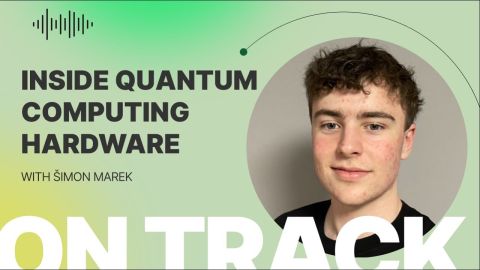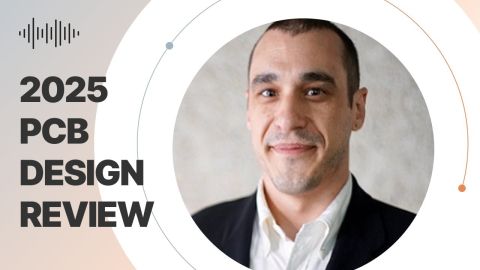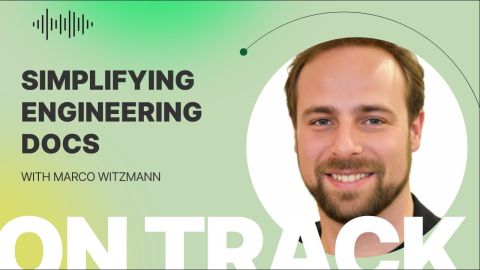The EMC Doctor is in: Ken Wyatt on EMI and PCB Health

The OnTrack Podcast is pleased to welcome Ken Wyatt (also known as the ‘EMC Doctor’). Ken began his career as a designer in the aerospace industry, and later worked for Hewlett Packard, where he found that his background in RF and Microwave engineering helped prepare him for his role as an Electromagnetic Compatibility (EMC) Engineer. His work has since taken him all over the world, where he develops and provides in-house training and delivers presentations and live demonstration; definitely unique among presenters!
Retiring early in 2008, Ken has since become a prolific author, co-authoring three books, including his latest, in which he identifies why products fail to meet EMI/EMC regulatory standards: ‘EMI Troubleshooting Cookbook for Product Designers’.
Ken currently provides seminars on a variety of EMC related topics—touching on subjects not often taught at the university level. He also provides EMC consultation, EMC compliance and precompliance testing, design reviews, and training services for commercial, military/aerospace, scientific, consumer, and computing industry sectors.
Listen to the Podcast:
Download this episode (right click and save)
Watch the video:

Show Highlights:
- Ken lays out his career path, from his beginnings in the aerospace industry, to his current role as a consultant.
- ‘EMI Troubleshooting Cookbook for Product Designers’—a quick look at the book Ken co-authored with Patrick G. André.
- Addressing the prevailing trends in stackups and board design in general.
- Old habits die hard: Why the PCB is the heart of most EMI and EMC issues today, and pitfalls to avoid to move past these issues.
- Signals as the flow of electrons in copper traces and wires: How our education may have left out the whole story with respect to high frequency design.
- How simultaneous trends toward diminishing device size and the Internet of Things contributes to desensing and other issues on PCBs.
- Staying “in the know”: Keeping up with our evolving understanding of the physics of PC boards and signal propagation is always challenging. Ken lays out some ways designers can stay up to speed.
- Why Electromagnetic Compability programs at the university level are few and far between, and how Missouri University of Science and Technology stands out among them.
- Case Studies: The trouble with dog trackers and blood transfusion machines. Ken discusses some challenges he’s come across in the field.
Links and Resources:
EMC Seminars
Ken Wyatt’s EMC blog
The EMC Blog (EDN)
Interference Technology Blog
Short video on the book with co-author Patrick André
Amazon author’s page
Ken Wyatt on LinkedIn
Ken Wyatt on Twitter: @emc_guru
See What's New in Altium Designer
Transcription:
Judy Warner:
Hi everyone, it’s Judy, welcome back to the OnTrack Podcast. Today’s guest is an EMC guru and he’s known as the ‘EMC Doctor’. He teaches around the world about EMI and EMC issues and he’s going to talk about why those issues have really come to originate now because of high speeds at the board level. He’s going to help you troubleshoot, he’s going to give you some tips and tricks and then we’re going to refer you to a whole litany of resources that you can tap into to save you a lot of time and headache. I hope you’ll enjoy this podcast with Ken Wyatt of Wyatt Technical Services.
Judy’s voice-over:
Welcome to Altium’s OnTrack Podcast where we talk to leaders about PCB design, tackling subjects ranging from schematic capture, all the way to the manufacturing floor. I’m your host, Judy Warner, please listen in every week and subscribe on iTunes, Stitcher, and all your favorite podcast apps and be sure to check out the show notes at altium.com/podcast, where you can find great resources and multiple ways to connect with us on social media.
J:
Well hi, Ken Wyatt, thank you so much for joining us today on the OnTrack Podcast, it’s good to see you again.
K:
It’s my pleasure.
J:
So, for our audience, Ken Wyatt and I have been connected on LinkedIn for a long time but we have never met in person. So, when I was at DesignCon a few weeks back, we connected and actually got to meet in person and I walked into his classroom and he had the coolest setup. He’s obviously an EMC consultant and specialist and he was teaching a class there, and I walked in and he had a lab coat, a stethoscope, the thing on his head, and he’s the EMC Doctor. [laughter] And so he had a neat camera pointing at a board and he had an oscilloscope and he had this fantastic… he was illustrating but then he was talking with this cool little camera set up and really showing people in real-time how these things look.
So I want to introduce you to Ken Wyatt, the EMS Doctor and I think you’re going to enjoy today. So Ken, tell us a little bit about your background in the industry, a little bit about Wyatt Technical Services, and how you became The EMC Doctor?
K:
Well, my background was originally in the aerospace industry for about ten years as a designer, everything from microwaves to DC to DC converters and I managed to get my foot in the door at Hewlett Packard as an EMC Engineer for the division of oscilloscopes here in Colorado Springs where I’m based and that was interesting. I have an RAF and microwave background and it transferred to EMC or electromagnetic compatibility and I developed some training for in-house and gave that all over the world and that was a great experience. And in 2008 I decided to retire myself a little early, and I have been consulting for the past ten years and the live demos are distinctive as far as my seminars go, not too many instructors use live demos and it’s kinda neat.
As far as my ‘EMC Doctor branding’ - it’s really perfect branding [chuckles]. I figure we should have some fun during seminars, so that’s how I’m usually introduced. A funny story, when I was speaking at G-Con in Israel, I was the last speaker in a two-day conference and when I was introduced, I came out with my doctor get-up and it just broke up the whole audience because up to that point it had been pretty serious and here’s this character coming out all dressed up as a doctor. [Judy laughs], so that’s just part of my routine now.
J:
Well, it definitely makes you memorable and it definitely put a smile on my face so I can see how that would work, especially, as you said, we can get very serious about ourselves in the “technical industry”. So, I think people really do enjoy having a little bit of fun and entertainment. For our listeners, I want to let you know up front that I’m putting a ton of resources in the show notes that you’re definitely going to want to go after. Ken is an author, a speaker, he has webinars, and you’re really going to want to tap into that. So, in case you’re driving to work or you’re finishing your work out, be sure I’m going to send you that in case you run out of time to listen. So, tell us a little bit about the work that Wyatt Technical Services does when you’re consulting now?
K:
Well, a big part of the business is design reviews for clients, I’ve been blessed to have a whole string of clients through the years, hundreds of companies and so we do design reviews, we help them do troubleshooting, sometimes remotely, sometimes on-site. I can also take their products here into my office and do quite a bit of probing and that sort of thing to try and figure out some mitigations. And I also do pre-compliance testing and show clients how to do that at their own facilities, and that’s often a very time-consuming thing to be troubleshooting back and forth between their site and the compliance test lab, which is usually a third party and so by teaching them to do their own radiated emissions, for example, in-house is a very time- and cost-saving thing to do. So, that’s something we add to our training.
J:
Well, I see you posting, I’ve been a Ken Wyatt fan for a long time, I see the resources that you post and I really like it. Briefly touch on the book that you mentioned to me earlier Ken?
K:
Oh sure, Patrick André and I (Patrick is a fellow consultant in Seattle) and the two of us were chatting one time at the IEEE EMC Symposium, and commiserating about the fact that a lot of our clients have the same issues repeatedly, so we decided to co-author a book, [holds up book] - this is it, the ‘EMI Troubleshooting Cookbook for Product Designers’ [Judy chuckles].
We wrote it for people who are designing products who don’t necessarily understand EMC and it’s been a very popular book among designers and actually was voted among the top eight EMC-related books by In Compliance Magazine so there’s a real need. It took us 18 months to do that book [laughs] but we were glad it was over and it’s been a real help to our clients.
J:
That’s awesome, and to our listeners again, below I shared Ken Wyatt or you can just go look at it, he has a great Amazon Author page where he has some of his publications so I recommend that as well.
K:
My website is emc-seminars.com and a lot of the show links are on that website if you’d like to order the books or check out some of the technical papers and so forth.
J:
Yeah, great. So, you and I were chatting about the prevailing problems de jure of EMC and EMI. Can you give us an idea, specifically since our listeners are PCB Design Engineers, what are prevailing trends or things that you’re seeing now relative to board design, and I think you mentioned something about stackups, could you touch on that briefly?
K:
Sure, a couple of decades ago the EMC issues were more system-level issues, where you connect the shield on your cables and shielding, bonding, cabling kinds of issues. Now with the higher clock and data rates, it seems like the PC board is really the heart of most EMI and EMC issues today. And, unfortunately, designers are still using PC board layout and stackup that was okay one or two decades ago, but today you cannot use those old rules and habits and so it seems to be all about PC boards now and the layout and the stackup especially. Designers don’t understand… you know, we weren’t educated properly in college, the assumption was always the signals were the flow of electrons and copper traces or wires; it’s true at DC but when you go to AC or transient or high frequency, you have to realize that the signal energy is propagated through the dielectric space between the microstrip and the return plane, so that really dictates the stackup today.
An example that I ran into frequently - a lot of product designers are incorporating wireless, cellular and UPS into their products and there’s a trend, more and more products are being designed for mobile use and smaller and smaller PC boards and so any EMI that’s generated on the board tends to get into the sensitive receivers of the cellular modules and GPS modules and it actually makes them less sensitive to reception and so that’s a big problem with a lot of my clients.
J:
So do you think the astronomical rise of the Internet of Things or the ‘Internet of Everything’ is really making this a problem area?
K:
Oh definitely, most of my recent clients are now producing IoT devices - a recent one I worked on was a video camera system used by law enforcement and the board was only 2 by 3cm in size and they’re cramming all this technology onto that board that’s double-sided and you have video camera coming in and GPS and multiple LTE cellular bands and wi-fi and Bluetooth and all this stuff and the antennas are just millimeters from the circuit board, and a product like that can be very challenging. When you have energy sources like DC to DC converters and digital processing and memory bus noise and stuff it’s a big challenge today.
J:
Yeah. So, is it also the speed, I’ve heard this from Lee Ritchey, Rick Hartly, Steve Sandler, talking about, because of the speed as well as wireless, all the rules that we were able to ignore, we can’t ignore anymore.
K:
Well, that’s true. When I was first designing circuits we were using wire-wrap technology, where everything was wires and the clock speeds back then were Megahertz, like 20 or 40 Mhz and you could get away with messing up your PC board design. Today you can’t do that, you really have to rely on understanding the physics of PC boards and how signals propagate and being able to use CAD programs like Altium to design your boards correctly, to begin with, is a big plus.
J:
So, obviously DesignCon is a great conference and there’s so much to learn there. What advice would you give… I feel like this disconnect is so ubiquitous and pervasive and I have so much compassion for EEs, they’re laying out their boards and it’s like shooting in the dark. How do you get up to speed, besides plug into all of Ken Wyatt’s stuff or go to DesignCon?
I know it’s a $60,000 question… but just wondering?
K:
Conferences like DesignCon are helpful, the best of the best designers attend there, so the training that you get at DesignCon is excellent, there’s a handful of us that are training in EMC and incorporating PCB design as part of that. You mentioned Rick Hartley, also Dan Beeker from NXP [inaudible] is a good PC board designer and trainer. You know it’s hard because these subjects are not taught in Universities and it’s hard to convince the administration to add even more topics to the basic information that they’re already teaching, so there’s a lot of reasons why it’s tough. One of the universities, the Missouri University of Science and Technology, has an excellent program for upper graduate level and postgraduate students in EMC, they actually have an EMC lab that’s a separate building.
J:
That’s amazing!
K:
Yeah, they actually have figured out how to fund that, and funding is an issue for a lot of colleges. So they partner with major corporations so that the corporations having various issues with their product development, they’ll let the students study and figure out the problems and the mitigations and in turn, will fund the university programs in EMC, so there’s a handful of universities around the world that incorporate EMC training but they’re few and far between.
J:
So there’s hope! Yeah, not enough but that’s encouraging to hear that that’s starting to happen. Could you give us some examples [or] some case studies of situations to put some meat on the bones of what we’ve been talking about? I’m sure you’ve seen a few war stories along the way?
K:
Oh, gosh yes, there are several wireless devices, vehicle trackers and even GPS trackers for your animals. I worked on a dog tracker for a company in Portugal actually.
J:
That’s interesting.
K:
And of course, their PC board was about 1.5cm which is really tiny, but a lot of times it’s all about the stackup. If you don’t get the signal spaces adjacent to the return plane, you’re going to get all kinds of coupling within the board and that’s very often where the trouble lies. I also deal with something called radiated immunity where a product needs to be designed to withstand 2-way radio and other high power transmitters, for example, ambulance equipment - some of the medical equipment requires higher immunity levels of RF transmission. One medical product I worked on is a blood transfusion machine - that’s the neat thing about consulting in EMC because you get to work on so many different kinds of products. This blood transfusion machine had some pump motors on it that were supposed to turn a few turns per second, and when it was being tested at certain frequencies - and it turned out to be frequencies in the LTE Cellular band, which is not great [laughter] - two of these motors took off at 10,000 RPM during the test…
J:
Oh boy!
K:
That’s probably fast enough to suck the blood right out of your patient! [laughter] Anyway, so they’d been working weeks on this and I developed simple characterizing tests, one of which you introduce a localized RF field through a small probe, and probe around their circuit boards and wiring and as I got the probe near these motors, they’d take off at 10,000 RPM.
J:
That’s crazy.
K:
And so, they’d been working for weeks going back and forth to the compliance test layout and we had it all figured out within two hours and had it mitigated and fixed.
J:
And how long had they worked on that before they called you?
K:
Oh weeks; it was like 3 months.
J:
I can’t believe how much money, besides the headache and frustration, that would save a company.
K:
Yes. Well, a lot of these little tricks and techniques are described in the book Patrick André and I co-authored, so it’s been very helpful.
J:
Well, we’re running out of time, unfortunately, but I wanted to mention that I’ve been twisting Ken’s arm a little bit because I enjoyed his talk so much at DesignCon, to maybe come present at AltiumLive in October, so fingers crossed and leave me a comment if you’d like to learn from Ken Wyatt at AltiumLive. We’d love to have you, so I’m pretty sure we can make that happen.
K:
And it was so nice to meet you at DesignCon finally and not only communicate on LinkedIn.
J:
Yeah, it’s a funny thing where I feel like I’ve known you for a long time but we’d never shaken each other’s hand, it was a neat thing to finally meet you in person.
K:
I also invite any of the listeners to connect via LinkedIn, I’m quite active there and every time I write an article I’ll post that [inaudible] on the platform.
J:
And I’ll share that, I’ll share your LinkedIn profile in the show notes and I highly recommend that you do that as well because that’s how I got to know Ken and see all this great content he’s putting out and it was nice of you to mention Rick and Dan Beeker and Steve Sandler, on the power integrity side. I feel very fortunate that through the podcast, LinkedIn, through DesignCon, AltiumLive is now attracting really some of the industry’s best experts to get this message out and hopefully bring the frustration down and the success up because I really feel a lot of compassion for people who have either intermittent problems or a problem that shouldn’t be there, yet it is. So, appreciate what you’re doing.
K:
Podcasts like yours are very helpful to get some of the industry people talking about some of these issues, so I appreciate the opportunity.
J:
Yeah, my pleasure. And I will tell you, as we close here, that people reach out to me all the time from inside the design community, even on a global scale, saying, “oh my gosh Judy, you’ve plugged me into these people that I never knew” or they live in Europe and they don’t have access and it’s what gets me up in the morning, Ken. Thank you for joining in with us again and to our listeners, thank you so much for tuning in today and learning from Ken Wyatt. As I said, check out the show notes, connect with Ken on LinkedIn and let us know if you’d like to see him speak at AltiumLive if that’s something you’re able to attend.
So appreciate you Ken, appreciate our listeners. We’ll see you next time, remember to like, subscribe and comment, until next time. Remember to always stay on track.









